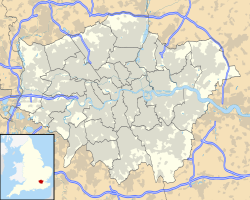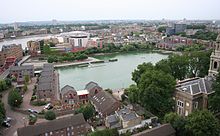Shadwell Basin
Location of the Shadwell Basin in Greater London |
The Shadwell Basin was part of the London Docks , a series of docks under the management of the London Dock Company in Wapping, London, and part of the Port of London .
Today, the Shadwell Basin is the most visible body of water that remains of the historic London Docks. It is on the north bank of the Thames between Tower Bridge to the west and Limehouse to the east.
Unlike the other parts of the London Docks, which were all backfilled, the easternmost Shadwell Basin was preserved. It now has 2.8 hectares of water, is used for recreational activities (such as sailing, canoeing and fishing) and is surrounded on three sides by attractive apartment buildings on its banks designed by leading British architects McCormac, Jamieson, Prichard and Wright were.
The houses have four or five floors and their facades, decorated with open arches or closed structures, reflect the old warehouses on the harbor basin of the 19th century, which had colonnades on the quays.
The Shadwell Basin has popular bike and footpaths and a walkway along the water as part of the adjoining outdoor area with canals between the river and the Hermitage Basin near the St. Katharine Docks to the west. As part of London's first closed port facility, the Shadwell Basin is one of the docklands that have been designed since the mid-1980s to provide free access to bodies of water and leisure facilities.
history
In the 1830s, the London Docks were expanded to the east, creating the "Estern Dock" and the Shadwell Basin (built 1828-1932). A new entrance from the Thames was therefore built at Shadwell . It opened in 1832 and was christened Shadwell Entrance (the main entrance to the docks was in Wapping and there was a third through the Hermitage Basin).
In the 1850s, the London Dock Company realized that both the Wapping and Shadwell entrances were too narrow for the larger ships that were gradually being put into service. In 1854-1858 a new driveway (13.7 m wide) and a new entrance basin was built in Shadwell, the only element of the London Docks that has survived to this day. It was connected to the western harbor basin by the Eastern Dock and the shorter Tobacco Dock .
At the beginning of the 20th century, the port facilities in Wapping proved to be out of date because they could no longer provide berths for the large steamships. The big ships were unloaded downstream and the goods were transported by barges to the Wapping warehouses. However, this approach was uneconomical and inefficient. Therein lies the reason why the port facilities in Wapping were one of the first to be closed in the 1960s.
The London Docks were closed to merchant shipping in 1969. The Shadwell Basin and the western part of the London Docks were acquired by the London Borough of Tower Hamlets and were initially turned into industrial wastelands, mainly unused land and water. In 1981 the site was bought by the '' London Docklands Development Corporation '' (LDDC) and in 1987 169 residential and apartment buildings were built in the former port facilities.
Known residents
- Politician
Member of Parliament for Poplar and Canning Town Jim Fitzpatrick for the Labor Party , MP since 1997
- Victorian era
Sir William Henry Perkin (1838-1907), chemist who discovered aniline purple , was baptized in St. Paul's Church in Shadwell.
- Earlier
- Captain James Cook (1728–1779) lived in the area and had some of his children baptized in St. Paul's Church in Shadwell.
- Jane Randolph (1720–1776), mother of United States President Thomas Jefferson , was born on Shakespeare Walk (a road that ran north to south across what is now the Shadwell Basin) and was also in St. Paul's Church in Shadwell.
- John Wesley (1703-1791) preached at St. Paul's Church in Shadwell


